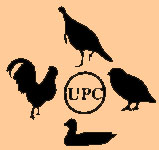|
“How Switzerland Got Rid of Battery Hen Cages” Now Available Online | ||||
| “Who when eating eggs remembers that animals must die for it?” – Heinzpeter Studer Machipongo, Va. – United Poultry Concerns is pleased to announce the online availability, in English, funded by UPC, of “How Switzerland Got Rid of Battery Cages.” Published in German in 2001, this 60-page book by Heinzpeter Studer traces the history of the battery cage in Switzerland from its first installation in 1935, through the “swirls of vehement discussions about the appropriateness of hen batteries” in the 1970s, to the abolition of battery cages in 1991. Studer, a social psychologist actively involved in the campaign, explains step by step how “[i]n contrast to widespread worldwide belief, Switzerland didn't generally prohibit batteries. It simply defined higher standards and hasn't authorized any more cage systems.” Starting with a national Animal Welfare Act in 1978 that set basic welfare standards with the approval of 81% of the Swiss popular vote – despite fierce opposition from egg farmers, whose arguments Studer presents – the campaign proceeded to a 1981 Animal Welfare Ordinance with regulations stipulating that “hens must be provided with at least 800 sq.cm [124 sq. in] accessible floor area per bird, with protected and shaded nests as well as with perches or gratings. Thus, the usual unstructured cage keeping was in fact prohibited; however, a scope for ‘furnished' cage systems remained.” Studer's discussion of the furnished, or “enriched,” battery cage is important to all efforts to end battery cages. An “enriched” cage has a tiny perch and nest box and a little bit of litter (sand or wood shavings) for pecking and scratching. The crowded hens have “extra” space the size of a postcard. They must still stretch their heads through bars to eat mash from a trough. Thousands of teensy “sandboxes” will increase the airborne debris in the caged environment, already mired in floating filth. The cost of maintaining and cleaning the intricately tiny “furniture,” Studer says, is so big that “in most cases it will be omitted.” Pressure to abolish cages totally must prevail, because “even ‘improved' cages lead to massive behavioral disturbances as they offer the hens only a little more space but no possibilities to withdraw” from aggressive cagemates. Aviaries – buildings with additional levels of platforms and perches interconnected by ladders – proved most successful in combining the basic needs of the hens with economics, Studer says. With color photographs and charts, he shows how aviaries “give the hens access to the third dimension appropriate to their species and allow the farmers to have a stocking density up to three times higher at a given base, which is nearly as high as in the former batteries, but with incomparably more freedom of movement for the hens.” This is not an ideal solution. Aviaries can be overcrowded, too, and the birds don't necessarily have access to sun, fresh air, grass, and litter, let alone the quality and depth of litter chickens need to encourage normal pecking and dustbathing behavior. There is no solution short of consumer rejection of eggs or keeping a few chickens oneself. Even free-range hen-keeping includes killing baby male chicks, slaughtering the hens, and disease outbreaks if hens are crowded and husbandry is poor. Asking “Is considering life too expensive?” Studer answers with a sketch of the ethical, economic and pleasurable benefits of keeping a few chickens naturally. Effective use of mass psychology is what ended battery cages in Switzerland, including a reduction of imported battery eggs from other countries, Studer argues. “Those who are to change their behavior must be motivated to do so,” he explains. The Swiss government, the two biggest Swiss food retailers, animal and environmental activists, the media, and the Swiss Egg Producers Association pulled together to create a positive image of the Swiss consumer proud to pay a little more for a healthier, more ethically-obtained egg. Alois Mettler, head of the egg producers association, is quoted: “We said over and over again that people want Swiss eggs, and we praised them for it. That increased the demand, since everybody wants what is demanded.” Problems including the use of processed eggs “where ethical aspects of production methods hardly attract any interest” remain. Yet progress has been, can and must be, made. Switzerland is not a “special case,” Studer says. “As long as battery keeping was allowed in Switzerland, the demand for eggs from animal-friendly keeping remained modest. It only increased on a grand scale when politics and the market implemented the virtual ban on cage keeping.” The book includes a moving Prologue “For a Hen”; a look at the EU, Germany, Australia, and New Zealand; an appendix that compares the Swiss animal welfare ordinance with the EU directive for the protection of laying hens; contact information; recommended reading; and a 10-point “Swiss recipe for the abolition of battery keeping of laying hens.” “How Switzerland Got Rid of Battery Cages” was translated by Anja Schmidtke and adapted for this publication by Pattrice Jones for United Poultry Concerns, a nonprofit organization that promotes the compassionate and respectful treatment of domestic fowl. www.upc-online.org | ||||
